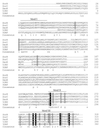Genetics of L-sorbose transport and metabolism in Lactobacillus casei
- PMID: 10613875
- PMCID: PMC94252
- DOI: 10.1128/JB.182.1.155-163.2000
Genetics of L-sorbose transport and metabolism in Lactobacillus casei
Abstract
Genes encoding L-sorbose metabolism of Lactobacillus casei ATCC 393 have been identified on a 6.8-kb chromosomal DNA fragment. Sequence analysis revealed seven complete genes and a partial open reading frame transcribed as two units. The deduced amino acid sequences of the first transcriptional unit (sorRE) showed high similarity to the transcriptional regulator and the L-sorbose-1-phosphate reductase of the sorbose (sor) operon from Klebsiella pneumoniae. The other genes are transcribed as one unit (sorFABCDG) in opposite direction to sorRE. The deduced peptide sequence of sorF showed homology with the D-sorbitol-6-phosphate dehydrogenase encoded in the sor operon from K. pneumoniae and sorABCD to components of the mannose phosphotransferase system (PTS) family but especially to domains EIIA, EIIB, EIIC and EIID of the phosphoenolpyruvate-dependent L-sorbose PTS from K. pneumoniae. Finally, the deduced amino acid sequence of a truncated gene (sorG) located downstream of sorD presented high similarity with ketose-1,6-bisphosphate aldolases. Results of studies on enzyme activities and transcriptional analysis revealed that the two gene clusters, sorRE and sorFABCDG, are induced by L-sorbose and subject to catabolite repression by D-glucose. Data indicating that the catabolite repression is mediated by components of the PTS elements and by CcpA, are presented. Results of sugar uptake assays in L. casei wild-type and sorBC mutant strains indicated that L-sorbose is taken up by L-sorbose-specific enzyme II and that L. casei contains an inducible D-fructose-specific PTS. Results of growth analysis of those strains and a man sorBC double mutant suggested that L-sorbose is probably also transported by the D-mannose PTS. We also present evidence, from studies on a sorR mutant, suggesting that the sorR gene encodes a positive regulator of the two sor operons. Sequence alignment of SorR, SorC (K. pneumoniae), and DeoR (Bacillus subtilis) revealed that they might constitute a new group of transcriptional regulators.
Figures







References
-
- Bradford M M. A rapid and sensitive method for the quantitation of microgram quantities of protein utilizing the principle of protein-dye binding. Anal Biochem. 1976;72:248–254. - PubMed
Publication types
MeSH terms
Substances
Associated data
- Actions
LinkOut - more resources
Full Text Sources
Other Literature Sources
Molecular Biology Databases
Miscellaneous

